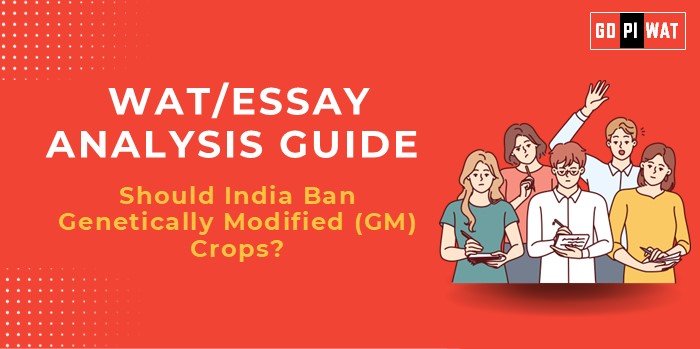📋 WAT/Essay Analysis Guide: Should India Ban Genetically Modified (GM) Crops?
🌐 Understanding the Topic’s Importance
GM crops lie at the intersection of technology, food security, and environmental ethics, making it a key topic for B-school discussions on sustainability and innovation.
⏳ Effective Planning and Writing
- Time Allocation:
- Planning: 5 minutes
- Writing: 20 minutes
- Reviewing: 5 minutes
- Preparation Tips: Collect relevant data on GM crops, their global impact, and India-specific challenges.
✍️ Introduction Techniques for Essays
- ⚖️ Contrast Approach: “While GM crops promise higher productivity, their uncertain ecological and health impacts cast a shadow on their adoption.”
- 🌟 Solution-Based: “India must explore genetically modified crops as a tool to balance food security with sustainability.”
📂 Structuring the Essay Body
- 🏆 Achievements: Cite statistics like Bt cotton’s success in increasing yield by 50% and reducing pesticide costs.
- ⚠️ Challenges with Comparative Analysis: Discuss ecological concerns, referencing Brazil’s GM soybean adoption and its biodiversity management policies.
- 🌟 Future Outlook: Suggest regulatory reforms, public engagement, and phased adoption for ensuring safety.
📄 Concluding Effectively
- ⚖️ Balanced Conclusion: “India’s cautious approach towards GM crops highlights the need for sustainable agricultural innovations.”
- 🌏 Global Example-Based Conclusion: “Adopting GM crops with robust safeguards, as seen in Brazil and the USA, can benefit India’s agricultural sector.”
✍️ Sample Short Essays
- ⚖️ Balanced Perspective: “India’s agricultural challenges call for innovation, yet GM crops must pass rigorous safety tests to gain public trust.”
- 🌟 Solution-Oriented: “With appropriate regulations, GM crops could revolutionize Indian farming, improving productivity while ensuring ecological balance.”
- 🌍 Global Comparison: “Following global leaders like Brazil, India can adopt GM crops with a focus on biodiversity conservation and public safety.”


